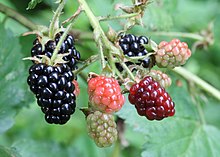Toxic Plants. Protecting your pet - A walk on the wildside
It isn't unsual for your pet to snuffle in the hedgerows, hoover up berries and do a bit of foraging, infact there are quite a few healthy snacks for them as you walk on the wild side.
Hawthorn Berries

Photo credit - Authors own photo
Hawthorn berries can be eaten by dogs. If they eat too many they could get an upset tummy but mostly they are safe to eat.
Do avoid any areas where you know they may have been sprayed with chemicals but otherwise they are a healthy snack on the move for dogs.
They shouldn't be misidentified as Bryony berries as they can look similar but Byrony are poisonous.
Bryony berries

Photo credit - Authors own photo
We found these Bryony berries in a hawthorn hedge.
At first glance they look simiilar and have the hawthorn leaves behind giving the impression they are Hawthorn berries.
Bryony berries don't have the blossom end (like the bit on the bottom bit of an apple core) and are much shinnier and redder.
Bryony berries are also easier to squash where as Hawthorn are slightly harder squash.
If you touch them, be sure to wash your hands as soon as you can as they are poinsonous to humans too.
The Bryony berries will also be on a string of plant whereas Hawthorn will be attached to a stalk.
If your dog eats Bryony, you need to get to a vet. The entire plant is toxic but the roots have the highest amount of toxin.
Hop

Photo credit - Authors own photo
You may also come across Hop which will be using hedgerows to scramble through to get to the light.
They smell lovely but the flower part (which is used for brewing beer) is toxic to dogs.
Its unlikely that your dog will be able to reach the hops as they do get quite high up in the hedges and trees but some of the flower can drop off, so watch out for them.
Dock (Rumex) flowers

Photo credit - Authors own photo
While your foraging with your dog, watch out for Nettles (usually they do not grow in Autumn and Winter), you might get stung but your dog should be ok their fur protects them.
The old tale, if you get stung by a Nettle a Dock leaf will stop the sting if you rub it where you have been stung is not true. Dock is toxic to dogs.
If you happen to try rubbing a Dock leaf on the site of a Nettle sting, don't let your dog lick it after.
They contain Oxalate which is very toxic to dogs and humans (but you probablly will not lick yourself if you have been stung).
Cooking the leaves is suppose to make them safe to eat but I still wouldn't give it to my dog.
Blackberries

Photo credit - Wikipedia
Black berries are quite safe for your dog to eat. The berries themselves are safe although they might get a few prickles trying to reach them.
Check your dogs paws after they have been rumaging around the hedgerows, to make sure they have no thorns or seeds stuck in their fur, paws or pads.
Some insects lay their eggs on and in the berries but dogs digestion usually deals with these.
So if your walking along footpaths in fields with hedges you may see a few of these berries and flowers, enjoy and stay safe, do not eat it if you can not identify it correctly.


 English
English
 Italiano
Italiano